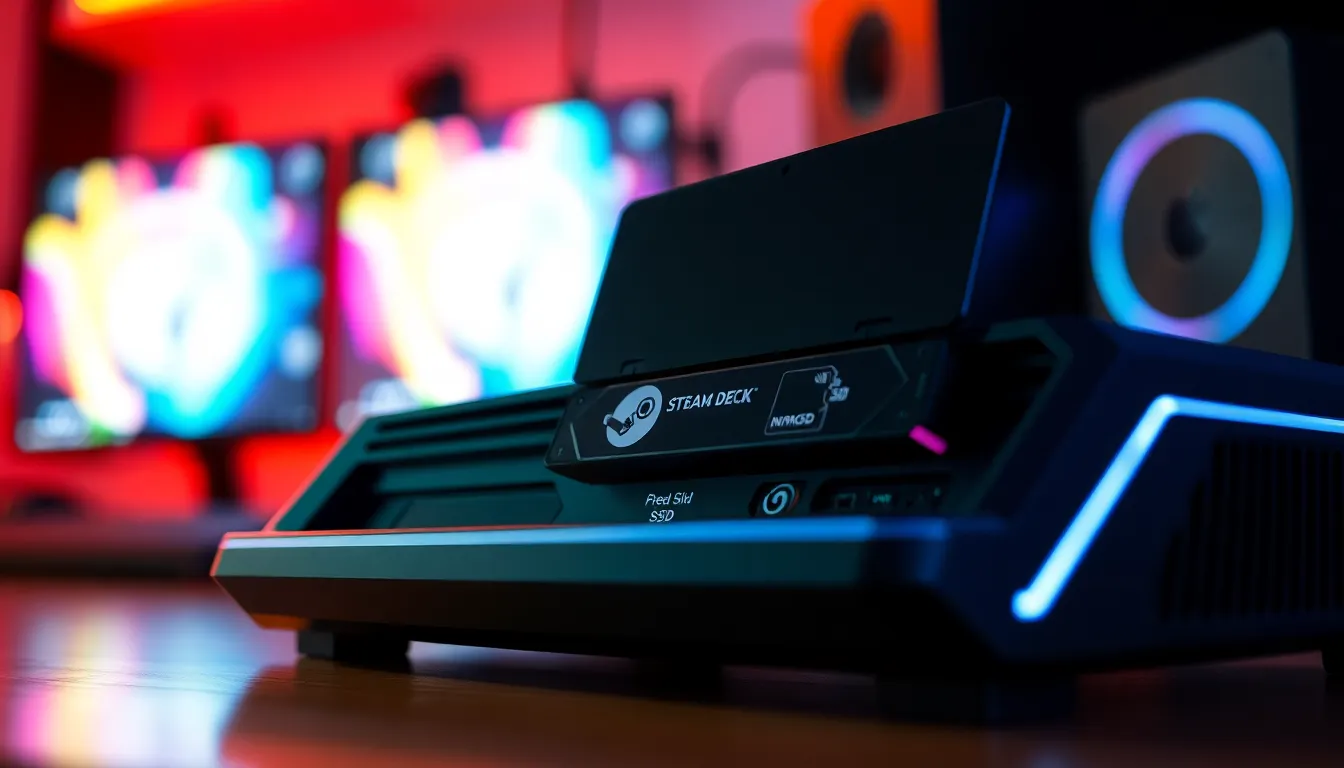Table of Contents
ToggleThe Steam Deck has taken the gaming world by storm, offering a portable solution for PC gaming enthusiasts. However, with a limited amount of built-in storage, many users quickly find themselves needing more space for their favorite titles. Fortunately, expanding the storage on a Steam Deck is not only possible but also relatively straightforward.
Whether it’s through microSD cards or external SSDs, there are several effective methods to enhance storage capacity. Understanding these options can significantly improve the gaming experience, allowing players to store more games and enjoy seamless access to their library. In this article, we’ll explore the various ways to expand storage on the Steam Deck, ensuring gamers can maximize their device’s potential without compromising on performance.
Overview of Steam Deck Storage Expansion
Steam Deck offers various options for expanding storage to address its limited built-in capacity. Users can choose from microSD cards, external SSDs, and USB drives. Each option has unique advantages and considerations, ensuring flexibility in meeting storage needs.
MicroSD Cards
MicroSD cards provide an affordable and portable storage solution. The Steam Deck supports microSD cards up to 1TB. When using microSD cards, performance can vary based on speed class. Users should choose cards rated UHS-I or better for optimal loading times.
External SSDs
External SSDs represent another effective method for storage expansion. They connect through the Steam Deck’s USB-C port, supporting fast data transfer rates. SSDs typically offer larger capacities, ranging from 256GB to several terabytes. Users can choose between powered and non-powered options, with powered drives requiring an external power source.
USB Drives
USB drives allow additional storage, though they may not provide the same speed as SSDs. Users can connect USB drives through the USB-C port, using adapters if necessary. It’s essential to select USB drives that comply with USB 3.0 or higher standards for better performance.
Storage Management
Managing storage effectively enhances the gaming experience. Regularly monitoring available space and organizing games by category or play frequency can streamline access. Utilizing Steam’s built-in library features also allows users to keep track of installed and uninstalled games efficiently.
Steam Deck storage expansion methods enable gamers to enhance their gaming libraries significantly. Understanding the options and their implications ensures that users maximize their device’s potential efficiently and effectively.
Types of Storage Expansion Options

Steam Deck users can choose from several storage expansion options to enhance their gaming experience. The primary options include microSD cards and NVMe SSDs, each offering unique advantages.
MicroSD Cards
MicroSD cards provide an affordable and portable storage solution for Steam Deck users. They support capacities up to 1TB, allowing ample space for numerous games. Performance varies by speed class, with Class 10 and UHS-I cards offering faster data transfer rates, enhancing load times. Samsung Evo Select and SanDisk Extreme are popular models that deliver reliable performance for gaming.
NVMe SSDs
NVMe SSDs serve as a robust solution for users seeking high-speed storage. Connecting via the Steam Deck’s M.2 slot, these drives offer superior transfer speeds, significantly improving game load times and overall system responsiveness. Available capacities range from 256GB to 2TB or more, with models like the Samsung 970 EVO Plus and Western Digital Black SN750 highly regarded for their performance. Users should install these drives carefully to avoid damaging the device’s internal components.
Benefits of Steam Deck Storage Expansion
Steam Deck storage expansion offers several advantages that significantly enhance the gaming experience. By utilizing various storage solutions, users can access more games and enjoy improved performance.
Increased Game Library
Increased storage capacity directly expands the gaming library. With options such as microSD cards, external SSDs, and NVMe SSDs, players can store more titles without worrying about space limitations. For example, microSD cards can support up to 1TB, allowing users to hold an extensive collection of games. This convenience enables gamers to carry an entire library on-the-go, eliminating the need to constantly delete and reinstall games.
Enhanced Performance
Enhanced performance results from using higher-speed storage solutions. External SSDs and NVMe SSDs provide faster data transfer rates compared to standard microSD cards. External SSDs connect via USB-C and can boost loading times for games, providing a smoother experience. NVMe SSDs, when installed in the Steam Deck’s M.2 slot, offer even higher speeds, significantly reducing wait times and increasing responsiveness. Players can enjoy seamless gameplay and quick access to their favorite titles, making the gaming experience more enjoyable overall.
Installation Process for Storage Expansion
Storage expansion on the Steam Deck is straightforward, requiring a few basic tools and an organized approach. Following the correct procedure ensures a successful upgrade.
Tools Required
- Phillips screwdriver: A small-sized Phillips screwdriver assists in removing the device’s back cover.
- Plastic spudger or pry tool: A spudger or pry tool helps safely detach the back panel without damaging the casing.
- Anti-static wrist strap (optional): An anti-static wrist strap prevents electrostatic discharge during the installation process.
- New storage device: Choose either a compatible microSD card or NVMe SSD for expansion based on desired capacity and speed.
Step-by-Step Guide
- Power off the Steam Deck: Shut down the device completely and disconnect the power supply.
- Remove the back cover: Use the Phillips screwdriver to unscrew the back panel. Carefully insert the spudger into the seam and gently pry the back cover open.
- Locate the storage slot: Identify the microSD card slot or M.2 slot for the NVMe SSD inside the device.
- Install the new storage:
- For a microSD card: Align and insert it into the slot until it clicks into place.
- For an NVMe SSD: Gently insert the SSD into the M.2 slot at a slight angle and secure it with the provided screw.
- Close the back cover: Reattach the back panel and fasten all screws securely.
- Power on the Steam Deck: Turn on the device and navigate to the settings to format the new storage if necessary.
Following these steps systematically enables users to expand their Steam Deck storage efficiently, enhancing gaming versatility and experience.
Considerations for Choosing Storage
Selecting the right storage for the Steam Deck involves evaluating speed, performance, and capacity. These factors significantly affect gaming experience and accessibility.
Speed and Performance
Speed and performance are critical when choosing storage options. MicroSD cards vary in speed class, impacting load times and data transfer rates. High-speed cards, such as UHS-I or UHS-II, enhance gaming by reducing lag during gameplay. External SSDs deliver faster read and write speeds compared to microSD cards, allowing seamless access to large files and minimizing loading times. NVMe SSDs, installed directly into the M.2 slot, optimize performance even further, enabling quick installations and fast game launches. Selecting storage that aligns with gaming needs ensures a smooth experience.
Storage Capacity
Storage capacity plays a vital role in accommodating game libraries. MicroSD cards support up to 1TB, offering ample space for numerous titles. Popular choices like the Samsung Evo Select and SanDisk Extreme balance capacity with affordability. External SSDs range from 256GB to over 4TB, providing flexibility for gamers with extensive libraries. NVMe SSDs also support substantial capacities, making them ideal for users focused on performance without sacrificing space. Assessing personal storage requirements helps gamers choose the appropriate capacity for their Steam Deck, preventing the hassle of frequent data management.
Expanding the storage on a Steam Deck is essential for gamers looking to enhance their experience. With options like microSD cards and NVMe SSDs available, users can choose solutions that best fit their needs.
Selecting the right storage method not only increases capacity but also boosts performance, reducing load times and improving overall system responsiveness. By understanding the various options and their benefits, gamers can enjoy a seamless and extensive gaming library on-the-go.
Ultimately, effective storage expansion transforms the Steam Deck into a more versatile gaming device, allowing for greater freedom and enjoyment in gaming adventures.





